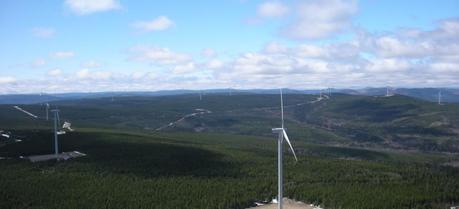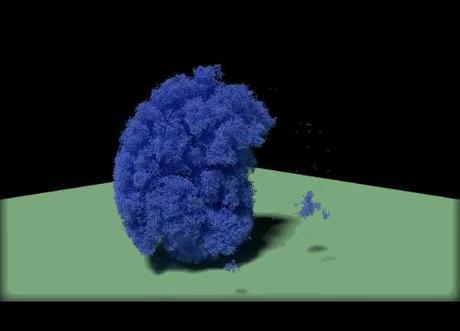 Caribou Wind Park as seen from the top of one of the turbines.
Caribou Wind Park as seen from the top of one of the turbines.A recent study of electrical power producing systems across Europe conducted by Siemens AG has shown that a lot of money can be saved by moving wind farms north. However, although cold weather itself is not a serious issue for wind turbines, ice accumulation is. The ice on the blades reduces their aerodynamic efficiency and can cause power losses as well as an aerodynamic imbalance of the rotor that could ultimately lead to a forced turbine stop. Ice on the wind turbine blades is also a safety risk to both humans and structures.

This simulation shows ice spreading through a water droplet. The image is a real scientific model that’s being developed on Titan, the #1 ranked supercomputer in the U.S. (Credit: Mike Matheson / Oak Ridge National Lab)
Scientists at GE Global Research (GRC) are already on the case. According to a recent blog post, they’ve been running ice forming simulations on the U.S. top-ranked supercomputer, Titan Cray XK7, at Oak Ridge National Laboratory to study how ice grows. Masako Yamada from GRC’s Advanced Computing Lab said that she can model water droplets that are 50 nanometers in size, far smaller than actual droplets, over incredibly short fragments of time called femtoseconds. (One femtosecond is to one second is what one second is to 31.7 million years.) “It’s analogous to creating a high-speed video using an atomic microscope,” Yamada said. “Titan is one of the few resources in the world that can handle our needs.”
Yamada and her team are using the research to develop icephobic surfaces that prevent ice creation and build up. This can be done by reducing “stickiness” between ice and surface, bouncing water droplets before they can freeze, delaying the onset of freezing, and lowering freezing temperature. “We can see exactly how the water molecules interact with the surfaces,” Yamada said. “This is simply impossible using any physical test. In addition, in the virtual world, the results are not impacted by dirt, defects and other random sources of noise.”
The research has applications everywhere, from windshields to the ideal ice cream scooper. “We have observed that certain types of surfaces hinder ice formation, but the exact mechanism was unknown,” says Rick Arthur, who leads the Advanced Computing Lab at GRC. “We use simulations as a means to gain insight into the conditions under which ice can be suppressed. Many industrial systems that operate in cold environments stand to benefit from resisting ice including wind turbines and offshore oil and gas drilling and production rigs operating in extremely cold environments.”

